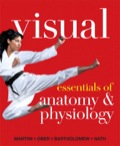
Concept explainers
To list and explain: The four general properties of immunity.
Introduction: The immune system provides defence against invading pathogens. It is a complex network of cells, organs, and proteins that provides immunity. The immunity can be differentiated into innate and adaptive immunity. The innate immunity provides non-specific defence against the invading pathogens, while adaptive immunity provides specific defence against pathogens.
Explanation of Solution
Specificity: The cells of the adaptive immunity are memory cells that are mostly of B-lymphocytes and T-lymphocytes. These cells specifically target and destroy the cells that have been previously encountered through antigen interaction during the maturation of these cells.
Tolerance: The immune cells can be able to distinguish between self-antigens (self-cells) and non-self-antigens (pathogens). These cells produce cytokines and antibodies to eliminate the pathogens. Moreover, the immune cells can also target and destroy the pathogens that have been never encountered before.
Memory: The cells of adaptive immunity are memory cells that register the previously encountered cells. When the same pathogens invade the host, these cells can quickly neutralize them by producing antibodies against them.
Versatility: The cells of the immune system can be able to identify different types of antigens from one and other. The immune cells produce specific immunoglobulins to each type of antigen they encounter.
Want to see more full solutions like this?
Chapter 13 Solutions
EBK VISUAL ESSENTIALS OF ANATOMY & PHYS
 Human Anatomy & Physiology (11th Edition)BiologyISBN:9780134580999Author:Elaine N. Marieb, Katja N. HoehnPublisher:PEARSON
Human Anatomy & Physiology (11th Edition)BiologyISBN:9780134580999Author:Elaine N. Marieb, Katja N. HoehnPublisher:PEARSON Biology 2eBiologyISBN:9781947172517Author:Matthew Douglas, Jung Choi, Mary Ann ClarkPublisher:OpenStax
Biology 2eBiologyISBN:9781947172517Author:Matthew Douglas, Jung Choi, Mary Ann ClarkPublisher:OpenStax Anatomy & PhysiologyBiologyISBN:9781259398629Author:McKinley, Michael P., O'loughlin, Valerie Dean, Bidle, Theresa StouterPublisher:Mcgraw Hill Education,
Anatomy & PhysiologyBiologyISBN:9781259398629Author:McKinley, Michael P., O'loughlin, Valerie Dean, Bidle, Theresa StouterPublisher:Mcgraw Hill Education, Molecular Biology of the Cell (Sixth Edition)BiologyISBN:9780815344322Author:Bruce Alberts, Alexander D. Johnson, Julian Lewis, David Morgan, Martin Raff, Keith Roberts, Peter WalterPublisher:W. W. Norton & Company
Molecular Biology of the Cell (Sixth Edition)BiologyISBN:9780815344322Author:Bruce Alberts, Alexander D. Johnson, Julian Lewis, David Morgan, Martin Raff, Keith Roberts, Peter WalterPublisher:W. W. Norton & Company Laboratory Manual For Human Anatomy & PhysiologyBiologyISBN:9781260159363Author:Martin, Terry R., Prentice-craver, CynthiaPublisher:McGraw-Hill Publishing Co.
Laboratory Manual For Human Anatomy & PhysiologyBiologyISBN:9781260159363Author:Martin, Terry R., Prentice-craver, CynthiaPublisher:McGraw-Hill Publishing Co. Inquiry Into Life (16th Edition)BiologyISBN:9781260231700Author:Sylvia S. Mader, Michael WindelspechtPublisher:McGraw Hill Education
Inquiry Into Life (16th Edition)BiologyISBN:9781260231700Author:Sylvia S. Mader, Michael WindelspechtPublisher:McGraw Hill Education





